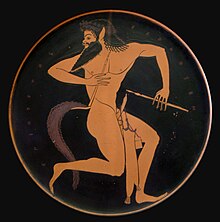
Back Sater Afrikaans ساتير Arabic Sátiru AST Satirlər Azerbaijani Сатир Bulgarian Satir Breton Satiri BS Sàtir Catalan Satyr Czech Satir CSB
 Attic red-figure plate from Vulci, Etruria, dated c. 520–500 BC, showing an ithyphallic satyr holding an aulos, a kind of ancient Greek woodwind instrument. | |
| Grouping | Legendary creature |
|---|---|
| Sub grouping | Mythological hybridNature spirit |
| Other name(s) | FaunSilenosselenussileni (plural) |
| Country | Greece |
In Greek mythology, a satyr[a] (Ancient Greek: σάτυρος, romanized: sátyros, pronounced [sátyros]), also known as a silenus[b] or silenos (Ancient Greek: σειληνός, romanized: seilēnós [seːlɛːnós]), and sileni (plural), is a male nature spirit with ears and a tail resembling those of a horse, as well as a permanent, exaggerated erection. Early artistic representations sometimes include horse-like legs, but, by the sixth century BC, they were more often represented with human legs.[4] Comically hideous, they have mane-like hair, bestial faces, and snub noses and they always are shown naked. Satyrs were characterized by their ribaldry and were known as lovers of wine, music, dancing, and women. They were companions of the god Dionysus and were believed to inhabit remote locales, such as woodlands, mountains, and pastures. They often attempted to seduce or rape nymphs and mortal women alike, usually with little success. They are sometimes shown masturbating or engaging in bestiality.
In classical Athens, satyrs made up the chorus in a genre of play known as a "satyr play", which was a parody of tragedy and known for its bawdy and obscene humor. The only complete surviving play of this genre is Cyclops by Euripides, although a significant portion of Sophocles's Ichneutae has also survived. In mythology, the satyr Marsyas is said to have challenged the god Apollo to a musical contest and been flayed alive for his hubris. Although superficially ridiculous, satyrs were also thought to possess useful knowledge, if they could be coaxed into revealing it. The satyr Silenus was the tutor of the young Dionysus and a story from Ionia told of a silenos who gave sound advice when captured.
Over the course of Greek history, satyrs gradually became portrayed as more human and less bestial. They also began to acquire goat-like characteristics in some depictions as a result of conflation with the Pans, plural forms of the god Pan with the legs and horns of goats. The Romans identified satyrs with their native nature spirits, fauns. Eventually the distinction between the two was lost entirely. Since the Renaissance, satyrs have been most often represented with the legs and horns of goats. Representations of satyrs cavorting with nymphs have been common in western art, with many famous artists creating works on the theme. Since the beginning of the twentieth century, satyrs have generally lost much of their characteristic obscenity, becoming more tame and domestic figures. They commonly appear in works of fantasy and children's literature, in which they are most often referred to as "fauns".
- ^ "satyr, n.", OED Online (Oxford: Oxford University Press, July 2018). Accessed 21 September 2018.
- ^ Wells, John C. (2009). "satyr". Longman Pronunciation Dictionary. London: Pearson Longman. ISBN 978-1-4058-8118-0.
- ^ "Silenus, n.", OED Online (Oxford: Oxford University Press, July 2018). Accessed 21 September 2018.
- ^ Gantz, Timothy (1996). Early Greek Myth. p. 135.
Cite error: There are <ref group=lower-alpha> tags or {{efn}} templates on this page, but the references will not show without a {{reflist|group=lower-alpha}} template or {{notelist}} template (see the help page).